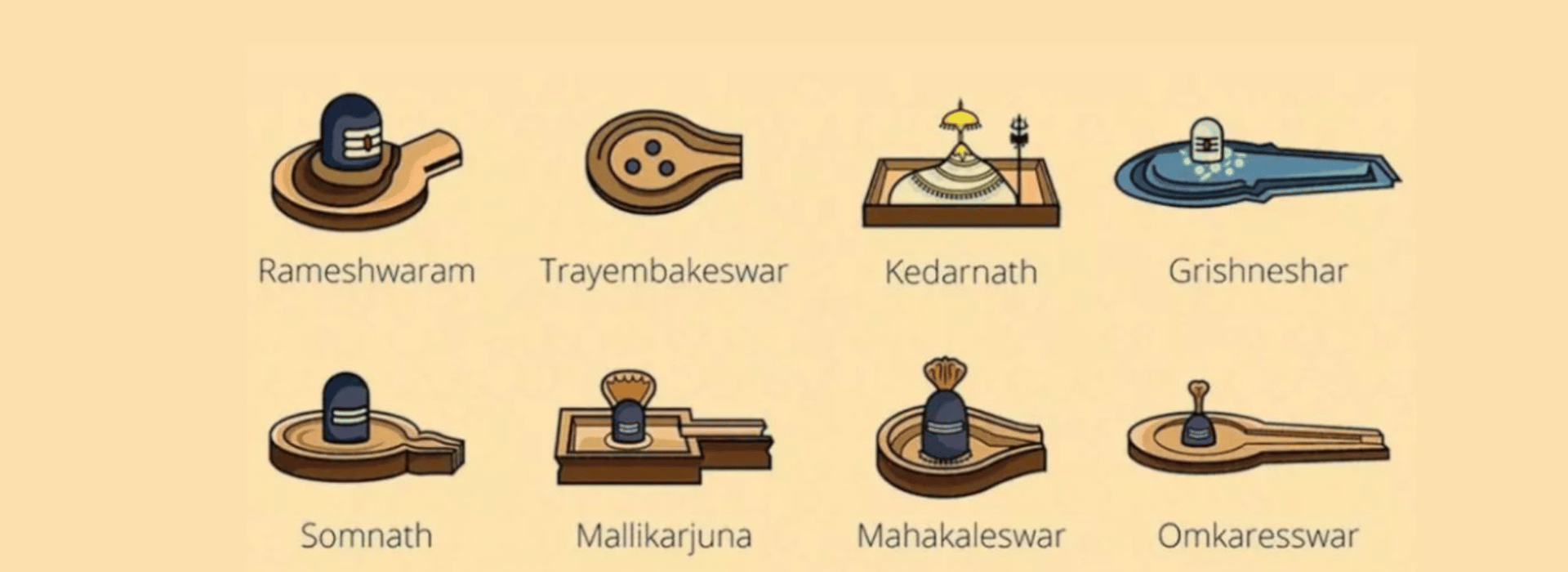All 12 Jyotirlingas
The Twelve Jyotirlingas are sacred temples dedicated to Lord Shiva, revered in Hinduism as powerful symbols of his divine presence. Each Jyotirlinga holds unique significance, attracting countless devotees eager to connect with their spiritual essence. The term “Jyotirlinga” combines “Jyoti,” meaning light, and “Lingam,” representing Shiva’s phallic form. These sacred sites represent a deep and meaningful connection with the divine. According to legend, on the auspicious night of Aridra Nakshatra, Lord Shiva manifested as a Jyotirlinga. While the physical forms of these lingas may seem similar, spiritually enlightened souls perceive them as fiery columns rising from the earth. Scattered across India, these 12 Jyotirlinga names and place lists serve as vital pilgrimage destinations for devotees seeking blessings and spiritual awakening.
Here is the 12 Jyotirlinga name and place list:
Somnath – Prabhas Patan, near Veraval, Gujarat
Mallikarjuna – Srisailam, Andhra Pradesh
Mahakaleshwar – Ujjain, Madhya Pradesh
Omkareshwar – Mandhata Island, Madhya Pradesh
Kedarnath – Kedarnath, Uttarakhand
Bhimashankar – Pune, Maharashtra
Kashi Vishwanath – Varanasi, Uttar Pradesh
Trimbak – Trimbak, Maharashtra
Vaidyanath – Deoghar, Jharkhand
Nageshwar – Dwarka, Gujarat
Grishneshwar – Ellora, Maharashtra
Ramanathaswamy -(Tamil Nadu)
These Jyotirlingas are not merely places of worship; they symbolize the rich spirituality and cultural heritage of India, making them essential pilgrimage sites for devotees seeking divine blessings and a deeper connection to the divine. The 12 Jyotirlinga name and place list encapsulates the essence of this spiritual journey across the country.
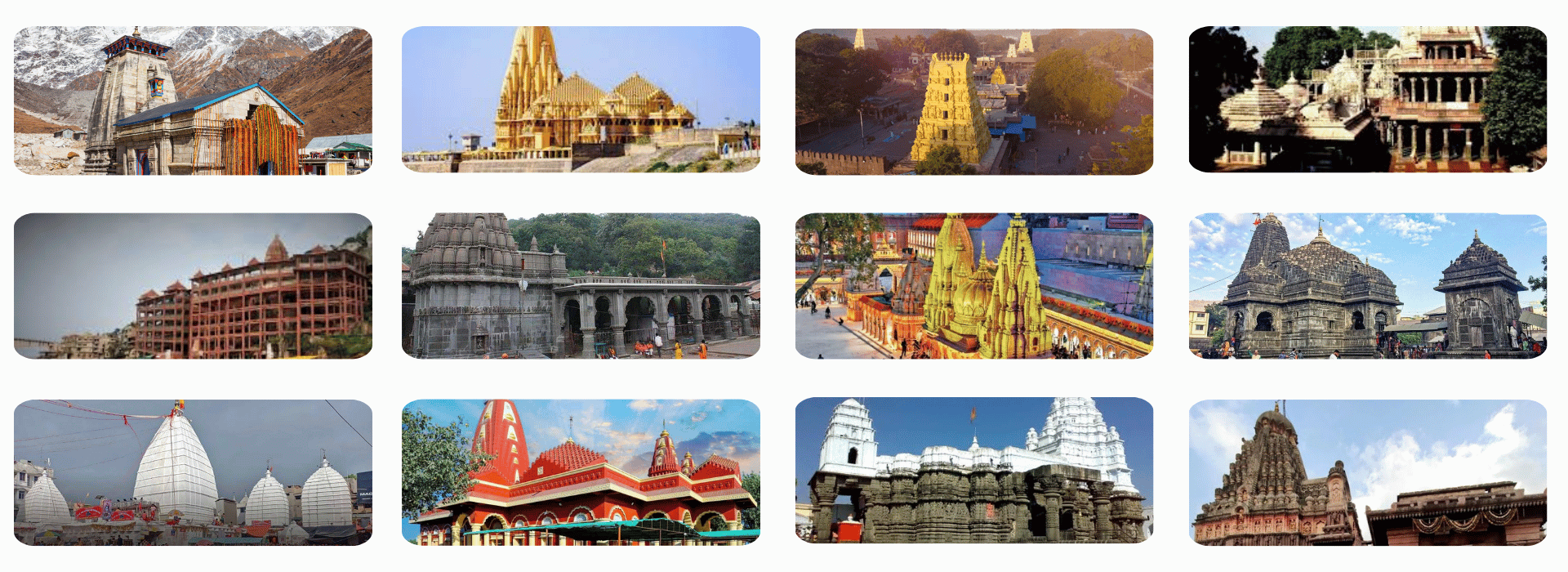
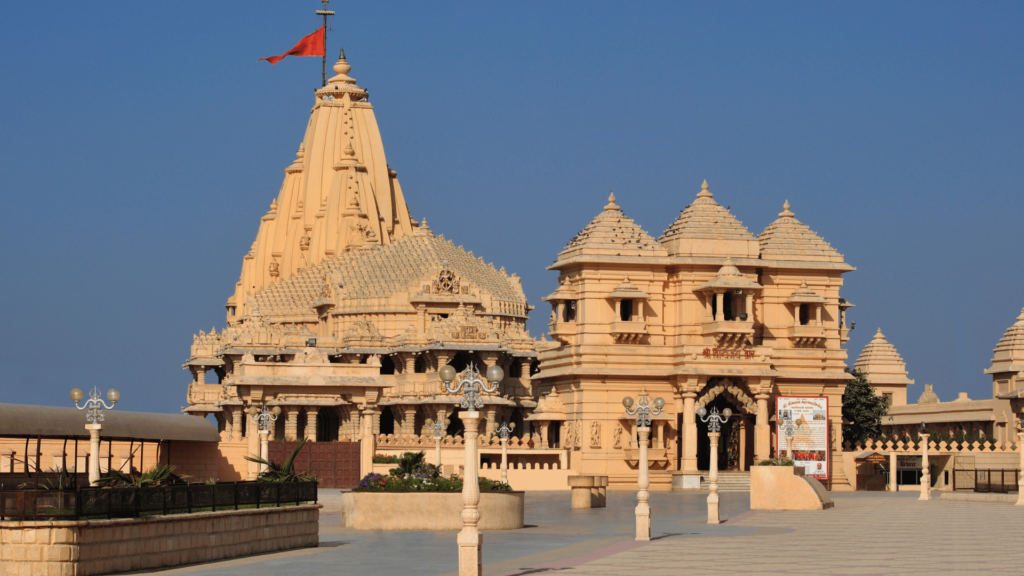
Situated on the western coast of India, the Somnath Temple is the first among the 12 Jyotirlinga name and place list, enveloped in a rich historical legacy. This sacred site has endured numerous reconstructions following various invasions, symbolizing resilience and unwavering devotion. According to tradition, the moon god, Som, worshipped Lord Shiva here, which is reflected in its name.
The temple’s serene location by the Arabian Sea enhances its spiritual charm, offering visitors breathtaking views of the Saurashtra peninsula. The architecture showcases stunning Chalukyan design, highlighted by its impressive 50-meter tall shikhra. Inside, the main shrine features beautiful shelving adorned with silver doors, intricate carvings, and a statue of Nandi. The spacious courtyard includes a grand mandapa with soaring arches, inviting devotees to immerse themselves in prayer. After their rituals, visitors can exit through a side door to find a tranquil spot overlooking the ocean, where sunlight dances on the waves.
The annual Kartik Purnima fair in November draws countless pilgrims, infusing the temple with vibrant energy and devotion, making Somnath not just a site of worship but a lively centre of spiritual life.
How to reach?
Somnath (Gujarat) – Located in Prabhas Patan, near Veraval. Accessible by road, rail, or air (nearest airport: Diu).
Timings: 6:00 AM to 9:00 PM
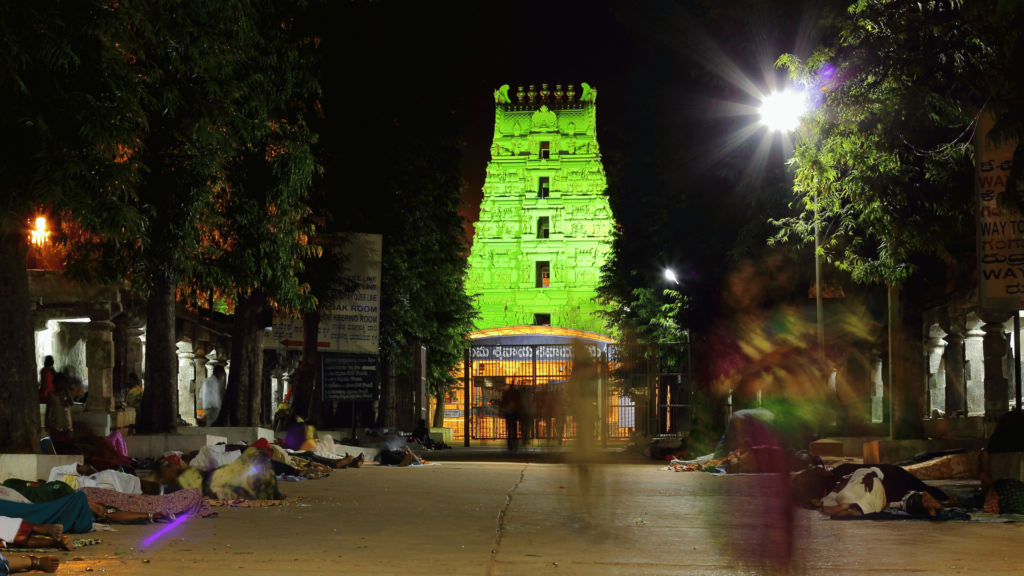
Nestled in the tranquil hills of Shri Shaila, the Mallikarjuna Jyotirlinga is a breathtaking destination that radiates serenity and spiritual energy.This revered temple embodies the divine bond between Lord Shiva and Goddess Parvati, attracting countless devotees from across the nation and beyond.Often referred to as the “Kailash of the South,” this sacred site is perched alongside the Krishna River, surrounded by lush forests and rich wildlife, making it an ideal retreat for those seeking spiritual solace.
At Mallikarjuna, Goddess Parvati is venerated as Bhramaramba, and Lord Shiva is honored as Mallikarjuna. The temple’s tranquil ambiance, coupled with its breathtaking natural scenery, provides an ideal backdrop for meditation and introspection.. Visitors often find themselves captivated by the spiritual energy that permeates the air, inviting them to connect with the divine.
As recounted in the Shiva Purana, Lord Kartikeya was overcome with deep sorrow upon discovering that his brother, Lord Ganesha, had married ahead of him.. In his sorrow, he withdrew to a remote mountain, choosing silence over communication with his parents. Worried for their son, Shiva and Parvati decided to step in and offer their support.. To uplift him, Shiva manifested as a Jyotilinga and took his place on Mallikarjuna Mountain.
Today, many believers hold that simply catching a glimpse of the mountain’s summit can cleanse one of sins, adding to the temple’s profound spiritual significance. This sacred site is also part of the 12 Jyotirlinga name and place list, each representing a unique aspect of Lord Shiva and offering a deep connection for those on a spiritual journey.
How to reach ?
Mallikarjuna (Andhra Pradesh) – Situated in Srisailam. Reachable by road or rail; the nearest airport is in Hyderabad.
Timings: 5:00 AM to 9:00 PM
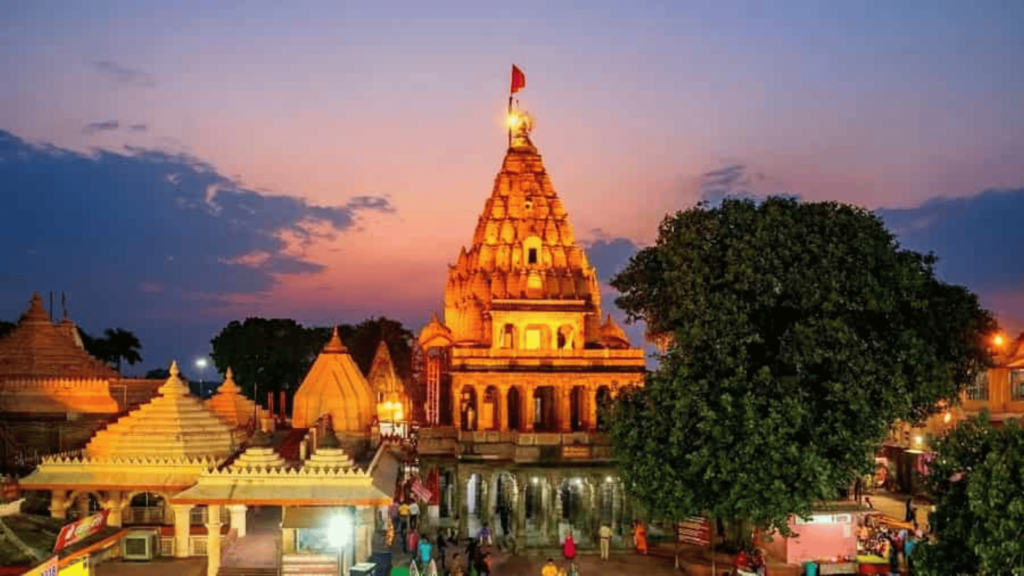
The Mahakaleshwar Jyotirlinga in Ujjain is a highly revered spiritual destination, renowned for its remarkable “Swayambhu,” or self-manifested, characteristics.. Nestled beside the tranquil Shipra River, this temple attracts countless pilgrims, especially during the Kumbh Mela.The Mahakaleshwar Temple, honored as one of the twelve sacred Jyotirlingas in India, is dedicated to Lord Shiva. Its famed Mahakaleshwar lingam, believed to have self-manifested, resides within an underground chamber, adding an air of mystique to the site.
Constructed in the mid-18th century, the temple rises five stories high, showcasing a captivating blend of Bhumija, Chalukya, and Maratha architectural styles. The marble pathways, beautifully restored by the Scindias in the late 1800s, enhance the temple’s grandeur. Inside the complex, the lingams of Mahakalesvara, Omkaresvara, and Nagachandresvara are positioned on various levels, with the Nagachandresvara lingam available only during Naga Panchami.. The site also features Koti Tirtha, a sacred tank built in the sarvatobhadra style, enriching the spiritual atmosphere.
Visitors can glimpse illustrations of the temple’s original architecture from the Paramara era (9th to 14th centuries) along the walkway leading from the tank to the temple. Many devotees arrive as early as 4 AM to participate in the special Bhasma Arti, filling the space with devotion and the soft glow of diyas. The Mahakaleshwar Temple stands not merely as a site for worship but as a vibrant embodiment of Ujjain’s rich faith and cultural heritage.
This holy site is included in the 12 Jyotirlinga name and place list, featuring other important temples devoted to Lord Shiva throughout India.. Each Jyotirlinga holds a unique significance, attracting devotees who seek spiritual fulfillment and a deeper connection with the divine.
How to reach ?
Mahakaleshwar (Madhya Pradesh) – Found in Ujjain. Ujjain is well-connected by rail and road; the nearest airport is in Indore. Timings: 4:00 AM to 11:00 PM
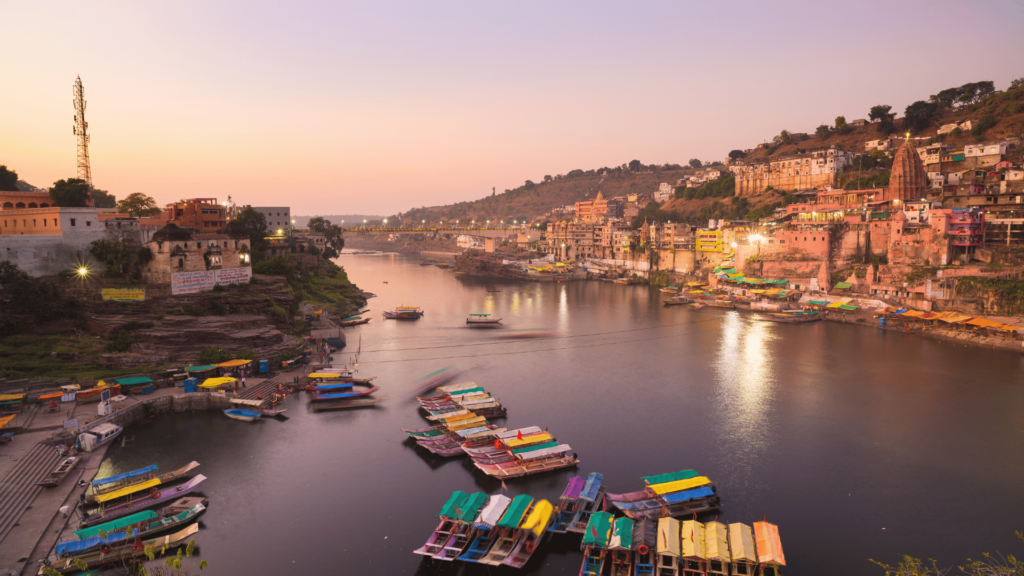
Omkareshwar lies on an island in the Mandhata district, distinctively shaped like the sacred “Om” symbol. Revered as one of the 12 Jyotirlinga temples dedicated to Lord Shiva, it is celebrated for its peaceful and spiritual atmosphere.
Devotees from around the world come seeking blessings at Omkareshwar, Madhya Pradesh, which is one of the twelve Jyotirlingas in the world. The temple is nestled on Omkar Mountain Island in the middle of the Narmada River, providing a deeply spiritual atmosphere. The spacious prayer hall, or sabha mandap, is supported by sixty massive brownstone pillars. Daily worship services are held here, and multiple deities are represented across its five stories. The temple trust leads the morning prayers, while priests from the Holkar and Scindia states conduct the other two daily rituals. Pilgrims often visit the nearby Mamleshwar temple as well, enhancing their journey. A holy dip in the Narmada River before entering the temple is believed to purify the soul and attract good fortune. Omkareshwar remains a beloved site among the 12 Jyotirlingas for those seeking both spiritual fulfilment and the beauty of nature.
How to reach ?
Mahakaleshwar (Madhya Pradesh) – Found in Ujjain. Ujjain is well-connected by rail and
road; the nearest airport is in Indore.
Timings: 4:30 am to 9:30 pm
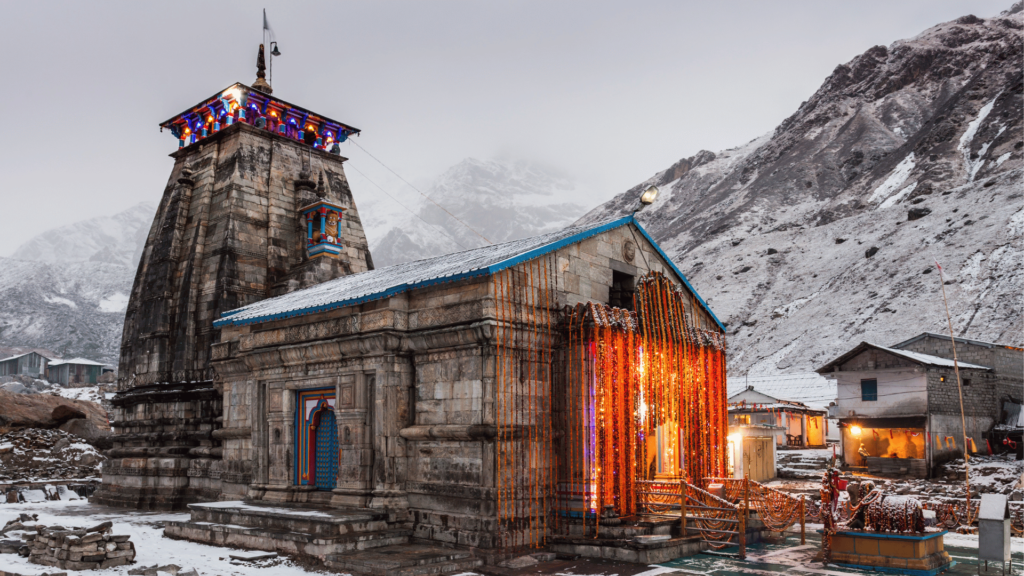
Kedarnath is a renowned pilgrimage destination nestled in the majestic Himalayas, known for its spiritual importance and stunning natural scenery. This sacred destination is accessible only for a limited period each year, drawing numerous devotees in search of peace and reflection.
The Kedarnath Temple, a vital component of the Char Dham pilgrimage, is one of the 12 Jyotirlingas in India and draws millions of visitors each year. Perched at an altitude of 3,584 meters, the journey to this temple dedicated to Lord Shiva is both physically challenging and spiritually rewarding. Kedarnath holds a special place in Hindu tradition as it features a distinctive conical rock formation in its sanctum sanctorum, symbolizing Lord Shiva’s manifestation as Sadashiva, the eternal auspicious one. Built over a millennium ago, the temple is constructed from large stone slabs and rests atop a rectangular platform, with Pali inscriptions adorning the steps leading to the inner sanctum.
Inside, the temple’s walls are beautifully decorated with intricate carvings depicting various deities and scenes from Hindu mythology. According to tradition, the temple was founded by the renowned philosopher Adi Shankaracharya in the eighth century, although it has undergone numerous restorations throughout its history. Each winter, heavy snowfall necessitates the idol of Lord Shiva being moved to Ukhimath, where it remains until the temple reopens in May. Kedarnath is also steeped in fascinating legends, including one in which Lord Shiva transformed into a bull to evade the Pandavas, who sought him for atonement after the Mahabharata war. When the Pandavas eventually discovered him, Shiva concealed himself underground, leaving only a hump visible on the surface. Today, Kedarnath remains a deeply revered site among the 12 Jyotirlingas and is part of the 12 Jyotirlinga name and place list, offering spiritual enrichment to all who visit.
How to Reach:
Kedarnath (Uttarakhand) is situated in the Himalayas and requires a trek from Gaurikund, which is reachable by road.
Timings:
Morning Darshan: 6:00 AM – 3:00 PM
Evening Darshan: 5:00 PM – 7:00 PM
Night Darshan: 7:30 PM – 9:30 PM (seasonal; temple closes during winter)
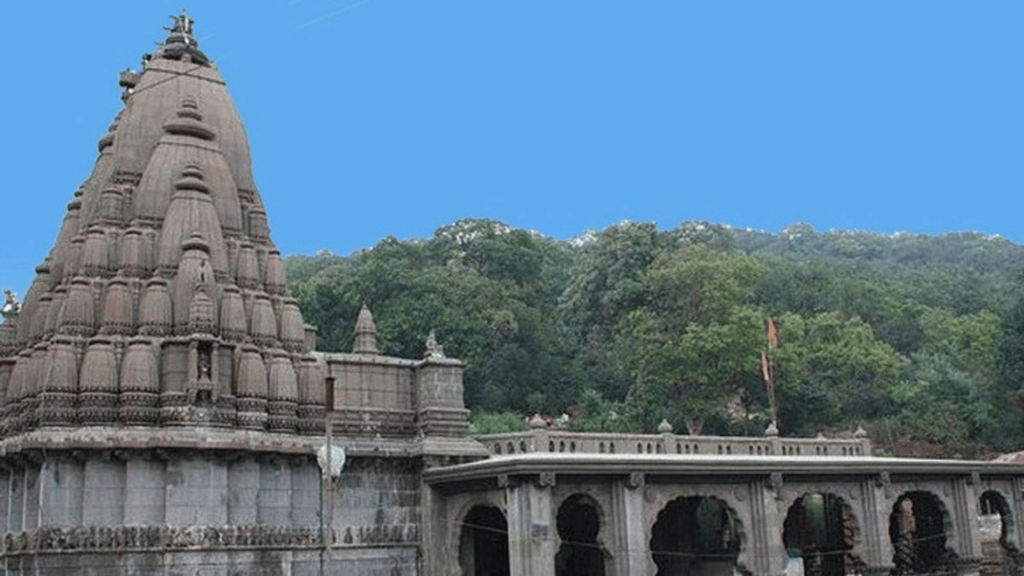
Set amidst lush forests and cascading waterfalls, Bhimashankar is a serene temple site that beautifully blends nature and spirituality. It also doubles as a wildlife sanctuary, making it a perfect destination for both nature enthusiasts and those seeking a spiritual retreat. The Bhimashankar Temple in Maharashtra is a revered shrine dedicated to Lord Shiva and is one of the twelve jyotirlingas, sacred symbols of Shiva across India. The 12 Jyotirlinga name and place list includes other significant shrines, but Bhimashankar stands out for its natural beauty. The temple’s sanctum sanctorum (garbha griha) and towering shikhara are crafted in the Nagara architectural style, featuring prominent influences from Rajasthani and Gujarati designs. The temple’s outer walls are intricately adorned with carvings depicting scenes from famous Indian epics like the Mahabharata and Ramayana, along with various legends of Lord Shiva and Lord Krishna. The courtyard holds ancient inscriptions that document donations to the temple, reflecting its deep historical importance.
Though the current temple structure was constructed in the 18th century by Nana Phadnavis, references to the shrine and the Bhimarathi River appear in texts as early as the 13th century. The Bhima River, which merges with the Krishna River near Raichur, originates in the Bhimashankar region, further enhancing the site’s cultural and natural significance. This unique combination of history, spirituality, and scenic beauty makes Bhimashankar a must-visit for any traveler.
How to reach?
Bhimashankar (Maharashtra) – Located near Pune. Accessible by road from Pune and has
nearby bus services.
Timings –
4:30 am – kakada aarti
5:00 am – Nijarup darshan
5:30 am – Regular Pooja, Abhishek starts
12:00 pm – Naivedya Pooja (no Abhishek inside )
12:30 pm – Regular Pooja and Abhishek starts
3:00 pm – Madhyan aarti (no darshan for 45 minutes)
4:00 pm to 9:30 pm – Shringar darshan ( no Abhishek inside)
7:30 pm – aarti
9:30 pm – Mandir closed
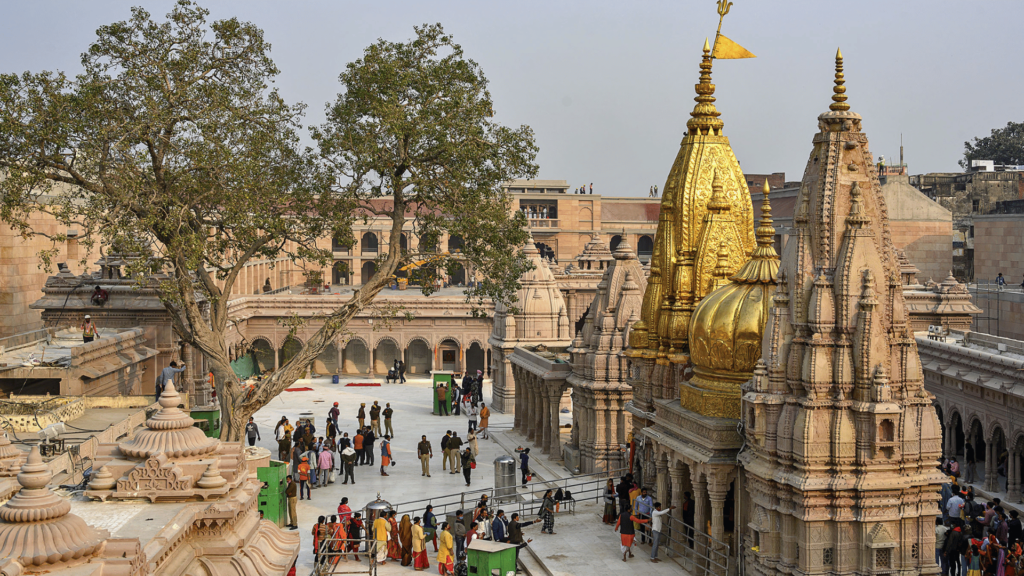
Vishwanath Mandir in Uttar Pradesh is one of Varanasi’s most revered sites, dedicated to Lord Shiva, the city’s presiding deity. Commonly referred to as the Kashi Vishwanath Temple, it holds great religious importance for Hindus.
Often referred to as the “Golden Temple” due to its gold-plated spire and dome, the temple attracts countless devotees. Its current structure was built in 1780 by Queen Ahilya Bai Holkar of Indore, and in 1839, Maharaja Ranjeet Singh of Punjab contributed the famous 15.5-meter-tall gold spire and dome. Nestled within a maze of smaller shrines and narrow passageways, the temple complex is a hub of activity, with shops lining the alleys selling handicrafts, trinkets, sweets, and paan (betel leaf). Devotees can visit the temple, known for its darshan (viewing of the deity), from 4 a.m. to 11 p.m. daily.
Adjacent to the Vishwanath Mandir are two other notable temples: Dundiraj Vinayak, dedicated to Lord Ganesha, and Annapurna Temple, honouring the goddess of food. The jyotirlinga inside the temple is one of the twelve sacred shrines of Lord Shiva in India, making it a particularly holy site. This temple is part of the 12 Jyotirlinga name and place list, which highlights its importance among these revered locations. Situated along the sacred banks of the Ganges River, the temple grounds also feature Jnana Vapi or the Wisdom Well. According to legend, the temple’s chief priest once concealed the jyotirlinga in the well to protect it from invaders, diving in to prevent its desecration. The temple holds a central place in Hindu mythology, with many revered saints believed to have visited to pay homage to the jyotirlinga. This profound spiritual and historical significance makes Vishwanath Mandir a must-visit destination for pilgrims and visitors alike.
How to reach?
Kashi Vishwanath (Uttar Pradesh) – In Varanasi, easily reachable by road and rail; Varanasi
has its own airport.
Timings: 3:00 AM to 11:00 PM
Reporting time for mangla aarti – 2:30 am
The Mangla Aarti – 3:00 am – 4:00 am
Bhag Aarti – 11:15 am – 12:20 pm
Shapt – Rishi Aarti – 7:00 pm – 8:15 pm
Shringar Aarti – 9:00 pm – 10:15 pm
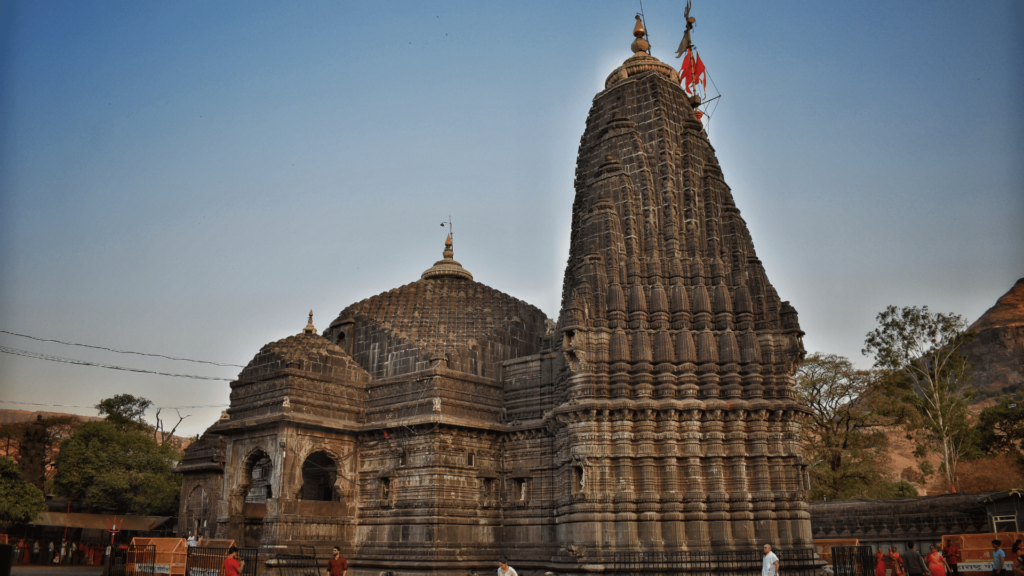
Nestled just outside Nashik, the historic Trimbakeshwar Temple stands as a testament to devotion and architectural beauty. Constructed during the reign of the third Peshwa, Balaji Bajirao (1740-1760), this temple replaced an older structure and is beautifully set against the backdrop of the Nilagiri and Kalagiri hills, at the foothills of Brahmagiri Hill.
Built entirely from black stone, Trimbakeshwar is a prominent pilgrimage site dedicated to Lord Shiva, located near Trimbak, the sacred origin of the Godavari River. A significant feature of the temple grounds is Kusavarta, a serene pond that marks the river’s source.
As one of the twelve revered Jyotirlingas, this temple holds great spiritual importance. The shivling here is unique, featuring three faces representing Lord Brahma, Lord Vishnu, and Lord Shiva. Adorned with a crown embellished with emeralds, diamonds, and other precious stones, the crown is displayed every Monday evening for an hour, drawing visitors for a glimpse of its grandeur. In addition to Shiva, the temple honors various deities, including Goddess Gangadevi, Lord Jaleswara, Lord Rameswara, Lord Gautameswara, Lord Kedarnath, Lord Rama, Lord Krishna, Lord Parasurama, and Lord Lakshmi Narayana.
While visiting, don’t miss the nearby Gangadwar Temple and the impressive Brahmagiri Fort, both offering a glimpse into the region’s rich cultural heritage.
How to Reach?
Trimbak (Trimbakeshwar) is easily accessible by road and rail, with Nashik being the nearest airport.
Timings: 7:00 AM – 8:00 PM

Vaidyanath Temple, also known as Baba Baidyanath Dham in Jharkhand, is a revered site where Lord Shiva is believed to have healed the demon king Ravana, earning the deity the title “Vaidhya,” meaning healer or physician. The temple’s tranquil surroundings further
enhance its spiritual atmosphere, attracting thousands of devotees each year. This sacred shrine is unique, as it is both a shaktipeeth—one of the holy sites where parts of Goddess Shakti are believed to have fallen—and one of the twelve jyotirlingas, symbols of Lord Shiva’s divine presence.
Dedicated to Lord Shiva, the temple also houses idols of Goddess Parvati and Lord Ganesha. The daily rituals begin early, with the head priest conducting shodashopachar, or sixteen forms of worship, at 4 a.m. Following this, devotees are allowed to offer their prayers to the Lord. According to legend, Ravana, the king of Lanka, performed intense penance here, sacrificing his ten heads in devotion to Lord Shiva. Moved by this act, Shiva descended to heal Ravana’s injuries, further solidifying the temple’s association with healing.
Historically, the temple has been significant for centuries, with records dating back to the 8th century AD during the reign of the last Gupta king, Adityasena Gupta. The temple pond, known as Mansarovar, is said to have been constructed by Raja Man Singh of Amber during the Mughal era. Architecturally, the temple is a simple stone structure crowned by a 72-foot-tall pyramidal tower that faces east. The tower is topped with three small golden vessels and a punchshula—five trident-shaped spears. A unique feature of the temple is the Chandrakanta Mani, an eight-petaled lotus symbol, which adds to the temple’s spiritual significance.
Baba Baidyanath Dham is a profound spiritual destination, blending legends, history, and architecture, making it a must-visit for devotees and pilgrims seeking divine blessings and healing.
How to reach ?
Vaidyanath (Jharkhand) – Located in Deoghar. Reachable by road or rail; nearest airport is in Jamshedpur.
Timings: 4:00 AM to 9:00 PM
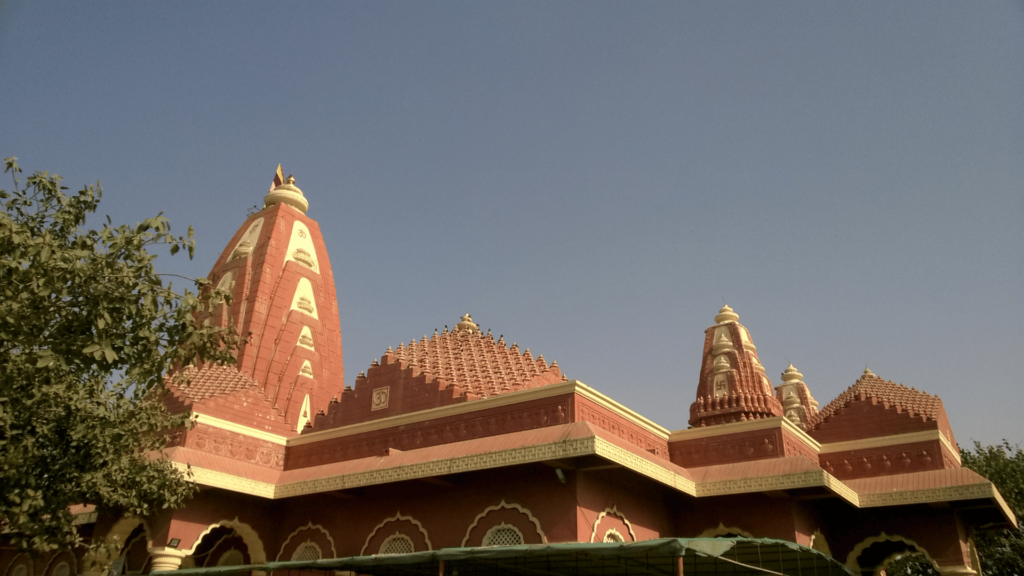
Located near Dwarka in Gujarat, the Nageshwar Shiva Temple holds deep spiritual significance, particularly for its association with the mythical serpent (Naga). Known for its towering 25-meter statue of Lord Shiva and tranquil surroundings, the temple offers a peaceful atmosphere for worshippers and visitors alike. It is one of the twelve jyotirlingas, revered shrines of Lord Shiva, and features a swayambhu (self-manifested) idol of the deity.
The temple, mentioned in the ancient Shiva Purana, is believed to be one of the oldest in the country. Its stunning architecture is complemented by lush, well-maintained gardens, creating a picturesque setting for spiritual reflection.
According to legend, a group of dwarf sages once worshipped Lord Shiva in the sacred forest of Darukavana. To test their devotion, Lord Shiva appeared before them as a naked ascetic adorned only with serpents. This caused an uproar, as the sages’ wives were drawn to the mysterious ascetic, abandoning their husbands. Furious, the sages cursed the ascetic, causing his linga to fall to Earth, shaking the planet. In response to the prayers of Lord Brahma and Lord Vishnu, Shiva agreed to restore balance and retrieved his linga. As a result, he vowed to remain in Darukavana as a jyotirlinga for eternity.
This rich blend of mythology, history, and natural beauty makes the Nageshwar Shiva Temple a revered destination for devotees and pilgrims, offering both a spiritual and scenic retreat.
How to reach?
Nageshwar (Gujarat) – Near Dwarka, accessible by road and rail; nearest airport is in Dwarka.
Timings: 5:30 AM to 9:00 PM
Mangal Aarti – 5:00 am to 5:30 am
Maha bhog Maha Aarti – 12:00 pm to 12:30 pm
Madhya Snana – 4:00 pm to 4:30 pm
Shayan Aarti – 8:30 pm to 9:00 pm
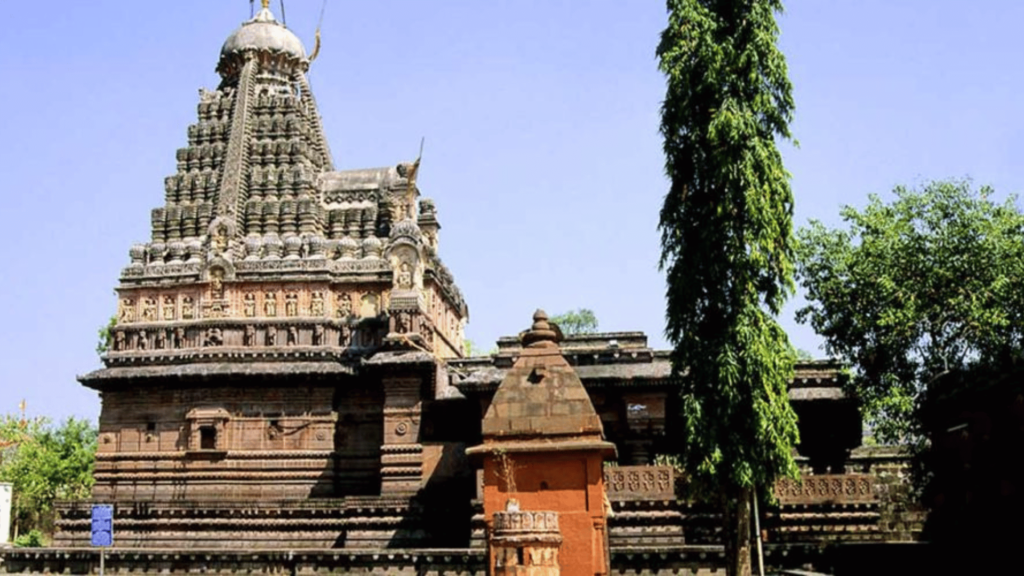
The Grishneshwar Temple, also known as Ghushmeswara, is the smallest of the twelve sacred Jyotirlingas and is situated near the famous Ellora Caves in Aurangabad, Maharashtra. This revered temple was built by Queen Ahilyabai Holkar of Indore in the traditional Maratha architectural style. Crafted from striking red and black stone, the temple is adorned with intricate carvings and beautiful designs that reflect the artistry of the period.
Located between the renowned Ajanta and Ellora Caves, Grishneshwar is not only a site of spiritual significance but also offers a rich connection to the region’s historical and cultural heritage. Its proximity to these UNESCO World Heritage Sites makes it a popular destination for both devotees and history enthusiasts, offering a serene yet historically vibrant experience for all who visit.
How to reach ?
Grishneshwar (Maharashtra) – Located in Ellora, near Aurangabad. Reachable by road from Aurangabad.
Timings: 5:00 am – 11:00 pm
Abhishekam Timing of Early morning – 6:00 am to 11:00 am
The afternoon Abhishekam Puja – 1:00 pm to 7:00 pm
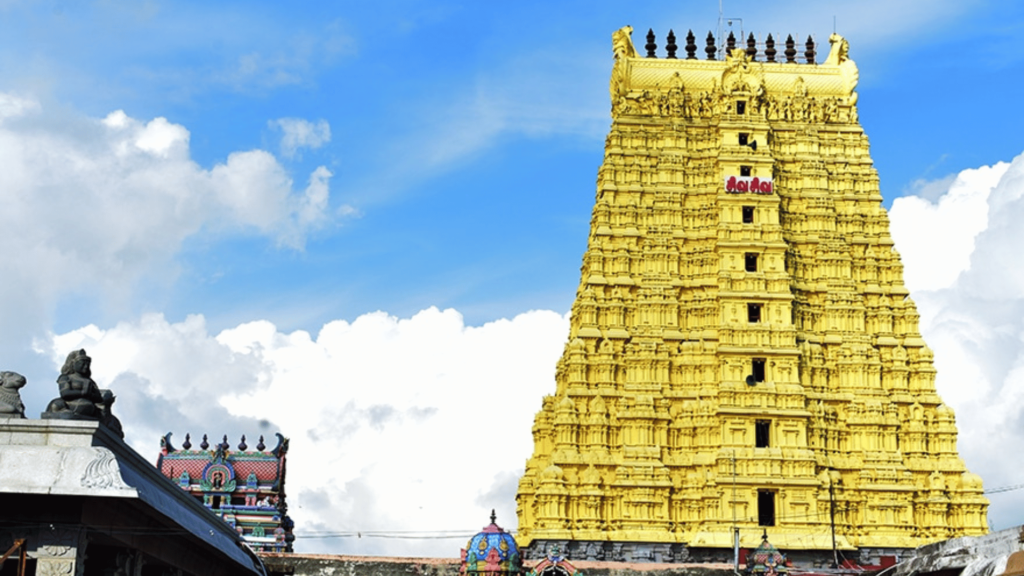
Ramanathaswamy Temple, located in the sacred town of Rameswaram, is deeply connected to the epic Ramayana and is one of the most significant pilgrimage sites in India. Dedicated
to Lord Shiva, it is home to one of the twelve jyotirlingas, making it a highly revered shrine. The name “Ramanathaswamy” means “Lord of Rama,” reflecting the legend in which Lord Rama worshipped Lord Shiva here before embarking on his journey to Lanka to rescue Goddess Sita from Ravana.
The temple is renowned for its architectural grandeur, featuring intricately carved sculptures, towering pillars, and imposing gopurams (temple towers). One of its most famous features is the temple’s massive corridor, which is the longest among all Hindu temples, containing 1,212 intricately designed pillars. Another unique aspect of the temple is its 22 theerthams, or sacred water baths, where devotees believe that taking a dip cleanses one of their sins.
The Sri Ramanathaswamy Temple is open to devotees every day from 5 a.m. to 1 p.m. and from 3 p.m. to 9 p.m., offering visitors both spiritual solace and a chance to admire its architectural marvels. With its rich mythological history and stunning design, the temple remains a must-visit for pilgrims and tourists alike.
How to reach?
• Ramanthaswamy (Tamil Nadu) – Located in Rameswaram Island. Nearest airport is Madurai (150 km away); train or bus services to Rameswaram are available.
Timings
Morning – 5:00 am to 1:00 pm
Evening – 3:00 pm to 9:00 pm


